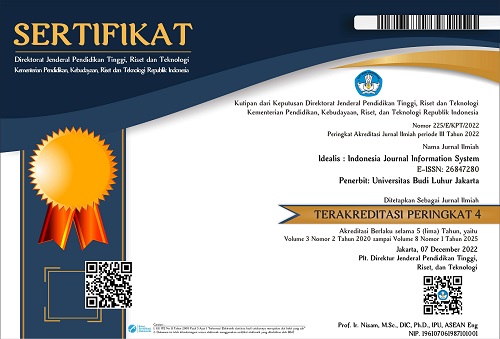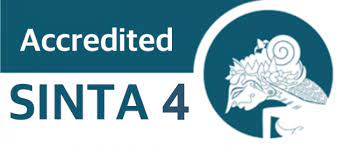ANALISIS PERBANDINGAN K-NEAREST NEIGHBORS DAN NAIVE BAYES UNTUK REKOMENDASI PILIHAN PROGRAM STUDI BAGI MAHASISWA
Abstract
The difficulty of choosing a study programme for graduates of Senior High School (SMA) and Vocational High School (SMK) is a big challenge for alumni. The challenge of career uncertainty in the future often makes the process of choosing a study programme even more complicated. Another challenge is that many high school alumni do not fully understand their interests and talents. In contrast to SMK graduates who have received education and internship work experience while at school. Parental pressure, cost factors, limited information that alumni have about their dream study programme, and choosing between interests and career opportunities are factors that are considered with parents. Thus, the problem of this research is what challenges are faced by high school graduates as well as vocational school graduates in obtaining adequate information about study programmes in dream universities and how graduates overcome confusion in determining study programmes that match their talents, interests and job prospects. To overcome this, the research aims to provide recommendations for prospective students in determining suitable study programmes based on their academic background and abilities. This study programme recommendation uses text mining methods by comparing the results of the accuracy value between the K-Nearest Neighbors (KNN) algorithm and the Naive Bayes algorithm. This algorithm comparison supports decision making. The data set used is three batches of student data totalling 347 data. Furthermore, the data is divided into training data and test data. The accuracy of the KNN method was recorded at 81.16% with a value of K = 2 and a proportion of test data of 40%. Naive Bayes accuracy reached 82.61% of Informatics Engineering study programme. The accuracy results do not show a significant difference, but the Naive Bayes method produces higher accuracy than KNN.
Downloads
References
[2] H. N. F. Fikrillah and D. Kurniadi, “Rekomendasi Pemilihan Program Studi Menggunakan Algoritma Naïve Bayes,” J. Algoritm., vol. 20, no. 1, pp. 42–49, 2023, doi: 10.33364/algoritma/v.20-1.1236.
[3] W. Handoko and M. Iqbal, “Prediksi Peminatan Program Studi Pada Penerimaan Mahasiswa Baru Stmik Royal Menggunakan Naïve Bayes,” J. Sci. Soc. Res., vol. 4, no. 2, p. 231, 2021, doi: 10.54314/jssr.v4i2.661.
[4] D. Putra and A. Wibowo, “Prediksi Keputusan Minat Penjurusan Siswa SMA Yadika 5 Menggunakan Algoritma Naïve Bayes,” Pros. Semin. Nas. Ris. Dan Inf. Sci., vol. 2, pp. 84–92, 2020, [Online]. Available: https://shorturl.at/wZtwb
[5] S. Nuraeni, S. P. A. Syam, M. F. Wajdi, B. Firmansyah, and M. Malkan, “Implementasi Metode K-NN Untuk Menentukan Jurusan Siswa di SMAN 02 Manokwari,” G-Tech J. Teknol. Terap., vol. 7, no. 1, pp. 89–95, 2023, doi: 10.33379/gtech.v7i1.1905.
[6] M. Y. Putra and D. I. Putri, “Pemanfaatan Algoritma Naïve Bayes dan K-Nearest Neighbor Untuk Klasifikasi Jurusan Siswa Kelas XI,” J. Tekno Kompak, vol. 16, no. 2, p. 176, 2022, doi: 10.33365/jtk.v16i2.2002.
[7] A. Mardiastuti, “Mengenal Rumus Slovin, Kapan Digunakan dan Contoh Soal,” Web Page. Accessed: Jan. 24, 2024. [Online]. Available: https://www.detik.com/jabar/berita/d-6253944/mengenal-rumus-slovin-kapan-digunakan-dan-contoh-soal
[8] U. Susilo and M. Arifin, “Analisis Hubungan Indeks Prestasi Semester Dan Indeks Prestasi Kumulatif Dengan Prestasi Mahasiswa Fakultas Ekonomi Universitas Kadiri,” J. Ris. Bisnis dan Ekon., vol. 1, no. 1, pp. 12–22, 2020, [Online]. Available: http://ojs.unik-kediri.ac.id/index.php/jimek
[9] A. Santoso, “Rumus Slovin:Panacea Masalah Ukuran Sampel?,” SuksmaJurnal Psikol. Univ. Sanat Dharma, vol. 4, p. 6, 2023, [Online]. Available: https://e-journal.usd.ac.id/index.php/suksma/article/view/6434/3637
[10] E. Erwin, V. C. Mawardi, and J. Hendryli, “Penggunaan Metode Collaborative Filtering Based Untuk Rekomendasi Kendaraan Bermotor,” J. Ilmu Komput. dan Sist. Inf., vol. 10, no. 1, pp. 3–7, 2022, doi: 10.24912/jiksi.v10i1.17796.
[11] J. Kalyzta, M. A. Willdan, S. Halfiani, and I. Indra, “Penerapan Analisis Sentimen Ujaran Kebencian Terhadap Vaksinasi Covid-19 Pada Tweet Berbahasa Indonesia Menggunakan Algoritme K-Nearest Neighbor,” IDEALIS Indones. J. Inf. Syst., vol. 5, no. 2, pp. 87–97, 2022, doi: 10.36080/idealis.v5i2.2959.
[12] K. Kartarina, N. K. Sriwinarti, and N. luh P. Juniarti, “Analisis Metode K-Nearest Neighbors (K-NN) Dan Naive Bayes Dalam Memprediksi Kelulusan Mahasiswa,” JTIM J. Teknol. Inf. dan Multimed., vol. 3, no. 2, pp. 107–113, 2021, doi: 10.35746/jtim.v3i2.159.
[13] M. A. Fahtu Rahman, Z. R. Mair, and D. Sartika, “Klasifikasi Ulasan Pelanggan Shopee Mall Terhadap E-Commerce Penjualan Baju Batik Metode Naïve Bayes,” IDEALIS Indones. J. Inf. Syst., vol. 7, no. 2, pp. 164–177, 2024, doi: 10.36080/idealis.v7i2.3178.
[14] E. Salim and A. Solichin, “Analisis Sentimen Pada Media Sosial Twitter Terhadap Pelayanan Dinas Kependudukan Dan Pencatatan Sipil Menggunakan Algoritma Naïve Bayes,” IDEALIS Indones. J. Inf. Syst., vol. 5, no. 2, pp. 79–86, 2022, doi: 10.36080/idealis.v5i2.2961.
[15] D. Normawati and S. A. Prayogi, “Implementasi Naïve Bayes Classifier Dan Confusion Matrix Pada Analisis Sentimen Berbasis Teks Pada Twitter,” J. Sains Komput. Inform. (J-SAKTI, vol. 5, no. 2, pp. 697–711, 2021, [Online]. Available: http://ejurnal.tunasbangsa.ac.id/index.php/jsakti/article/view/369/348
[16] R. Rusliyawati, K. Muludi, A. Wantoro, and D. A. Saputra, “Implementasi Metode International Prostate Symptom Score (IPSS) Untuk E-Screening Penentuan Gejala Benign Prostate Hyperplasia (BPH),” J. Sains dan Inform., vol. 7, no. 1, pp. 28–37, 2021, doi: 10.34128/jsi.v7i1.298.
Copyright (c) 2025 nurwati nurwati, Yudi Santoso

This work is licensed under a Creative Commons Attribution-ShareAlike 4.0 International License.














.png)

